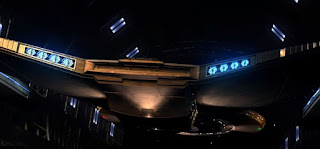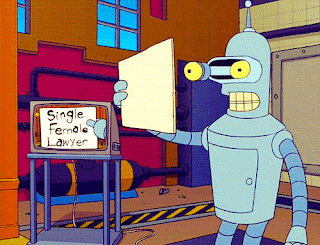Thar be spoilers ahead. I don't believe in spoilers, but that doesn't mean that you don't. IDIC.
You've been warned.
I decided to invest some of my limited cash flow into paying the matinee price to see the new Star Trek movie. I don't regret having seen it, but I'm sure that not eating just one more meal will make me regret how I used the money. Nevertheless, I saw the movie.
 |
| Actually, this awesome tribute to TMP is totally appropriate to this film. |
I have never made it a secret that I had my misgivings about this film prior to its release. I do my best to reserve judgement because trailers can be misleading and so can
statements from actors.
In my head, I went in with as clean a slate as I could.
The previews did little to impress upon me that I was wrong about my misgivings. All of them, every single one, was a crazy action movie. Yes, even Rogue One: A Star Wars Story is technically a crazy action movie.
I like crazy action movies. They're fun, and so cool!
But that's not usually what I like from Star Trek.
If it's what you like from Star Trek, well, bully for you. You've got plenty to enjoy.
 |
| Do no harm, Bones. |
I was very impressed with Star Trek Beyond. There are a lot of indications that writers Simon Pegg and Doug Jung aren't just fans of Star Trek, they did their homework. For the most part.
 |
| The U.S.S. Franklin was supposed to be the first Warp 4 capable ship after the NX-01's Warp 5 capable engine...? |
The movie started off in Kirk's headspace as he tries to figure out just what the hell happened that got him to where he was. This isn't dissimilar to where Kirk was at the beginning of TWOK, but the important difference here is that the original Kirk was older and more experienced by that point. He had always known he wanted to be a starship captain.
Kelvin Timeline Kirk felt shoehorned into the role of starship captain (and he kind of was, to be fair). Even comforting words from Bones weren't enough to stop Kirk from questioning what the hell he was really doing in deep space.
Rather than simply question the validity of Starfleet as a means of getting the action going, the beginning of the movie was very slow and thoughtful. The characters were questioning their sense of free will in a timeline in which they were pigeonholed into certain roles in order to take on specific threats.
The great comraderies that were developed naturally over the course of years working together didn't happen in the Kelvin timeline. They were merely a product of the Prime Timeline's Spock suggesting that it was necessary. That's all a bit deterministic.
 |
| I could not deprive you of the revelation of all that you could accomplish together, of a friendship that will define you both in ways you cannot yet realize. |
One of the best developments of Star Trek Beyond is the use of Bones. No secret, Bones has always been one of my favorite characters in Star Trek. In the original series, Bones was sassy and opinionated to a fault. He was the perfect foil for Spock. It was his relationship with Spock that helped Spock stand out so well.
Kirk was always a man apart in TOS. Yes, he was friends with Spock, and they had their moments together. But the best moments of true friendship were defined by Spock's interactions with Bones.
This necessarily meant that Uhura take a backseat in Spock's life for the duration of this movie. She still does some kick ass stuff, but I do feel as though they missed some opportunities with her newly liberated character.
The introduction of a new character, Jayla, is rather interesting. She is almost entirely glossed over from the standpoint of an origin except that the Bad Guy shot down her ship and killed her parents in front of her. Now she's a ninja whose home is an old NX-class starship.
Okay. There have been flimsier pretexts to introduce characters that were less cool. I liked her, a lot.
 |
| Plus she has this rad relationship with Montgomery Scott instead of fawning over James T. like a traditional Trek Girl |
My favorite visual in Beyond is one that I cannot find with a Google image search. It's the wide view of Krall's base, and I love it because it reminds me
so much of the design of so many TOS era wild alien bases. It is made of basic shapes and primary colors and a few technological-looking poles.
 |
| This is the closest I could find, and if you zoom in you can kind of see what I'm talking about. |
In TOS, often the planets they visited, when they weren't carbon copies of the Earth ("What are the odds, an exact duplicate of Earth?") were rocky with tall jagged spires and these buildings made of simple architecture. If you don't already know the story of why TOS was so colorful, it had to do with the fact that most people watching it in 1966 were doing so on black and white televisions so different colors needed to pop in order to be distinct shades of gray.
 |
| Like this image of Delta Vega (which became an ice planet where Kirk finds Scotty in the 2009 reboot) |
In addition to visuals that were throwbacks to TOS, they also brought to bear the full might of 2016's visual effects capabilities in the form of the starbase Yorktown. Yorktown is simply incredible, and even the characters are in awe of it.
 |
| This wide shot does not do the Yorktown justice. |
The interior of Yorktown is an MC Escher-like dream of advanced architecture. Great long corridors for starships run through the bubble and underneath the station's thoroughfares in such a way that occasional water features will reveal stunning views of the passing starships within. This is the kind of science fiction utopia that I think Gene Roddenberry would have been proud of, especially as a symbol for the unity of the United Federation of Planets.
There were some things that I was not terribly impressed with, visually.
 |
| This really weird shot of the Enterprise's torpedo launcher, for example. |
Some of Justin Lin's choices for visuals fit really well into more avant-garde action flicks. And, while there's plenty of action in Star Trek Beyond, these shots are less appropriate artistic choices and more food for the audience members that just want to hurry up and get to the 'splodey bits.
Actually, the action that was built up to in Star Trek Beyond felt very appropriately justified, even by Star Trek's non-violence preference. The villains did most of the actual shooting and, to be fair, they started it.
 |
| STOP BLOWING HOLES IN MY SHIP! |
Krall's true identity was a bit predictable, but maybe that's because I've seen the premise used in Star Trek before.
 |
| Like when Kirk stumbled across this magnificent bastard. |
But the tie-in to the storyline in Enterprise was fantastic. I
loved that the villain is an ex-M.A.A.C.O. who went nuts after he was put in a peaceful position. I
loved that he referenced the Xinti invasion and the Romulan War.
I didn't care that his pretense for being alive was flimsy (reference Zefram Cochrane's excuse in TOS). That wasn't really relevant to the story.
 |
| Oh, the Enterprise references were more than just vague mentions of "Admiral Archer's dog" in this movie. |
Krall was a good villain with a good enough backstory to support his motivations. He even seemed like he had a moment for redemption right there when Kirk was struggling with the last panel to save Yorktown from the virus he created.
 |
| This is the face of a sympathetic villain |
Is he misguided? Sure. But a lot less than Nero was in his strange attempt to get revenge on the Federation instead of... I don't know... warning Romulus about its impending destruction. What villain isn't misguided, though?
Krall's motivations, if not his capabilities, are similar to John DeLancie's Q character from Star Trek: The Next Generation. This is a villain who wants humans to stop exploring space because he thinks they'll break under the pressure of a galaxy that's too large for them to handle.
 |
| Literally the first episode of TNG is about this very premise |
Betwixt the action-filled parts of the movie, the drama of Kirk's and Spock's decisions to remain in their fated positions on board the Enterprise plays out as a strong B-plot. Spock is mortally wounded early on in the movie, and so the threat of his destruction weighs heavily on him in light of the recent death of Ambassador Spock (that trouble-making scallywag!)
Should he continue in starfleet? Or should he help rebuild Vulcan?
There's a lot less obvious wordplay around this conundrum, which allows his character to form his own opinions and demonstrate them through actions by
acting. This is something Zachary Quinto is particularly good at, so it was nice to let him do that. By the end of the movie, Spock decides to follow his feelings rather than logic. He prefers the company of his friends to the duty of maintaining Vulcan heritage. This reunites him somewhat with Uhura, at least on the level of being friends, and we love him for it. *waves a flag* Yay, friends!
Kirk, however, realizes that he does actually like to do stupidly dangerous shit for a living. I don't think Kirk would fare well in the 24th century; I think TNG would be too urbane for him. Even the Kirk from TOS, who is often depicted as far more violence-prone than he actually was, feels this way by the time he meets up with Jean-Luc Picard in Star Trek: Generations..
James T. Kirk is a thrill seeker. So he remains, but he is able to use this movie as a vehicle to discover it for himself.
The movie concludes with a touching connection to the TOS crew in the form of affectations left by Ambassador Spock for his alternate self.
 |
| Almost half of these wonderful human beings are dead. Fully half if you consider William Shatner to be dead inside. |
The movie ends on an upbeat note with the crew returning to space in the NCC-1701-A Enterprise. I feel like they weren't very ambitious with the design of the refit Enterprise in the Kelvin Timeline compared to the Prime Timeline, but it's functional enough for them to blow it up in the next movie.
 |
| Engage! |
Overall Star Trek Beyond was a strong ensemble movie that was, despite Chris Pine's best attempts to convince us otherwise, a thought-provoking journey about the role of destiny in deciding our fate. With lots of cool 'splosions.
Live long and prosper, friends!
























































